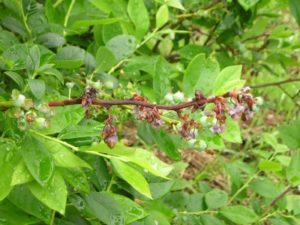After participating at The Blueberry Growers Association – Virtual Spring Field Day Trials, which during this time of the year Phomopsis twig blight is a hot topic! Did you know CS 2005 is labeled for Anthracnose, Bacterial Canker, Fruit Rot, Phomopsis Twig Blight and showcasing great results with Algal Stem Blotch in blueberries? Phomopsis twig blight is one of the most common canker disease of blueberries and can severely decrease yields, particularly on susceptible varieties. Losses result from premature ripening of the fruit, decreased productivity due to death of stems or entire plants, and rotted fruit.

An article titled Phomopsis Twig Blight of Blueberry by Daniel J. Anco and Michael A. Ellis, Department of Plant Pathology of Ohio State University. Here is a part of that article regarding Symptoms and Disease Cycle.
Symptoms
Shortly after green tip, symptoms become visible. Infected buds become brown and die. A necrotic, brown lesion forms on the twig around the blighted bud, and the sunken necrotic area spreads as the disease progresses. On stems, Phomopsis twig blight symptoms may be confused with symptoms of Fusicoccum canker. Wounds that are infected can result in girdling cankers that kill the entire twig. Later in the growing season, leaf spots may develop. Stems that are infected may wilt during summer, causing their leaves to change color (red or brown) prematurely. A fruit rot can also develop at harvest. Infected fruit become very soft and split easily.
Disease Cycle
Phomopsis twig blight is caused by the fungus Phomopsis vaccinii. The fungus survives the winter in dead or infected twigs. From bud break to bloom, fungal spores ooze from small black structures (pycnidia) on previously infected twigs and are spread by rain or overhead irrigation. These spores infect flower buds, and the fungus spreads into and through the twig to other flower and leaf buds. The fungus does not, however, grow into and infect older wood.
Fruit Grower News also had a great article titled, Twig blossom blights in Michigan blueberries need attention and gives an overview of symptoms to look out for.
Control Phomopsis twig blight with CS 2005!
25.6-51.2 oz. every 7 days (Minimum Retreatment Rate (lbs Cu2+/A)
100-200 ppm. PPM (Parts Per Million) copper per 100 gallons of water
Instructions: Dormant Application: Begin applications when bloom buds begin to swell. Make additional applications at 10 to 14 day intervals or as needed before blooms open.
For Application Rates table if you are spray +/- 100 gallon of water per acre, please refer to our Applications Rates Table
See full article for control recommendations from Daniel J. Anco and Michael A. Ellis. Magna-Bon did not participate in trials with Ohio State University.
Sources:

